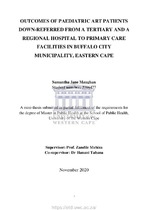| dc.description.abstract | Background: According to the Joint United Nations Programme on HIV/AIDS (UNAIDS) 340 000 children between 0-14years of age are living with HIV in South Africa as of 2019. Decentralization of HIV services was included in South Africa’s paediatric guidelines since 2010 in a bid to improve access to care. The current study sought to address the paucity of Eastern Cape (EC) data on the outcomes of down-referred paediatric antiretroviral therapy (ART) patients. These outcomes included retention in care (RIC) and virological suppression after 12 months Methodology: This retrospective analysis was conducted in the Buffalo City Municipality (BCM) district of the EC. The study population included HIV positive males and females, 0-14 years of age at transfer, who were initiated on ART at a tertiary or a regional hospital and subsequently down-referred, between June 2013 and June 2017. Data were collected from electronic databases at the facilities (Tier.net), patient files and patient registers. A descriptive analysis was performed using SPSS Statistics software version 26. Results: In total, 80.1% of patients successfully down-referred to a primary healthcare (PHC) facility, in a median of 42 days. Of those, 95.4% of patients were retained in care at 6 months and 93.1% at 12 months after arrival, with a median of 4 scheduled monthly visits missed. For those with results, virological suppression was maintained in 96.7% of patients at 6 months, 92.2% at 12 months and 96.2% for the entire post-transfer period of 2-14 months. In the 2-14 months post down-referral only 76.9% of patients had at least one viral load (VL) result and 50.3% had one CD4 result. For those with results, immune response (IR) to ART was maintained in 100% of patients at 6 months, 94.3% at 12 months and 97.7% in the 2-14 month period post successful down-referral. Conclusions: This study confirmed that loss to follow-up (LTFU) and treatment interruption at the point of transfer are significant risk factors for paediatric ART patients. This study also demonstrated high levels of RIC once patients had successfully down-referred. However, missed clinic visits suggest possible treatment interruptions for many patients post down-referral. While good virological and immunological responses to ART were maintained at the PHC facilities, suboptimal VL and CD4 monitoring was highlighted by the low proportion of available results. Therefore, while there are a number of issues to address, this study confirms that down-referral is a feasible option for up-scaling paediatric HIV care in the EC. | en_US |

